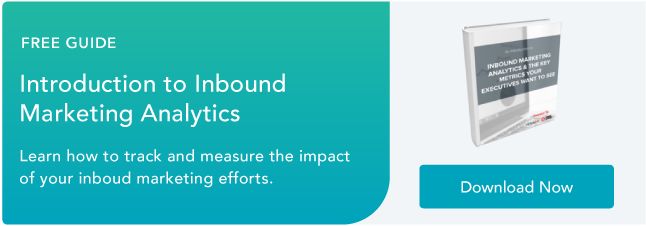Please visit Search Engine Land for the full article.
Monday, November 30, 2015
Google Image Search Lets You Save Images For Later With Stars
Please visit Search Engine Land for the full article.
Why Customer Match is the biggest thing to happen to email since Hotmail
Sunday, November 29, 2015
The Best Times to Send Business Emails This Holiday Season [New Data]

This post originally appeared on HubSpot's Sales Blog. To read more content like this, subscribe to Sales.
We’ve finally found an effective email strategy. Our open and clickthrough rates are optimized -- or so we thought.
Until one December morning when our metrics plummet. It must be a mistake.
Or, it’s the holiday season. Each year from November to January, email behavior changes and email strategies lose their effectiveness.
To combat this, we decided to look at 4,513,689 emails to analyze exactly how the holidays impact our one-to-one emails. The presentation below reveals all our never-before-shared insights.
Let's explore.
How have the holidays impacted your email activity? Share your experiences in the comments section below.
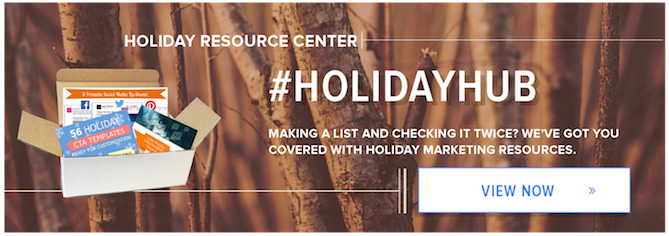
Saturday, November 28, 2015
How to Create a 'To-Don't' List: A Productivity Trick for Focusing On What Really Matters [Infographic]

This post originally appeared on HubSpot's Sales Blog. To read more content like this, subscribe to Sales.
When I got my first job, I was given one piece of advice over and over again: Say yes. Say yes to every opportunity that comes your way, raise your hand for side projects, and generally go above and beyond.
Going above in your role is a great way to learn and grow. But sometimes, saying no is just as important. And while you're probably already familiar with the to-do list, there's another list out there that might be even more valuable.
The to-don't list, as its name suggests, itemizes all the things you won’t do throughout your day.
Developed by Tom Peters, author of In Search of Excellence, this tool helps you focus on what’s actually important and serves as a conscious reminder of what’s not.
So what does a to-don’t list actually look like? Use the guiding questions in the infographic below to create your own, and check out what Daniel Pink includes on his to-don’t list.

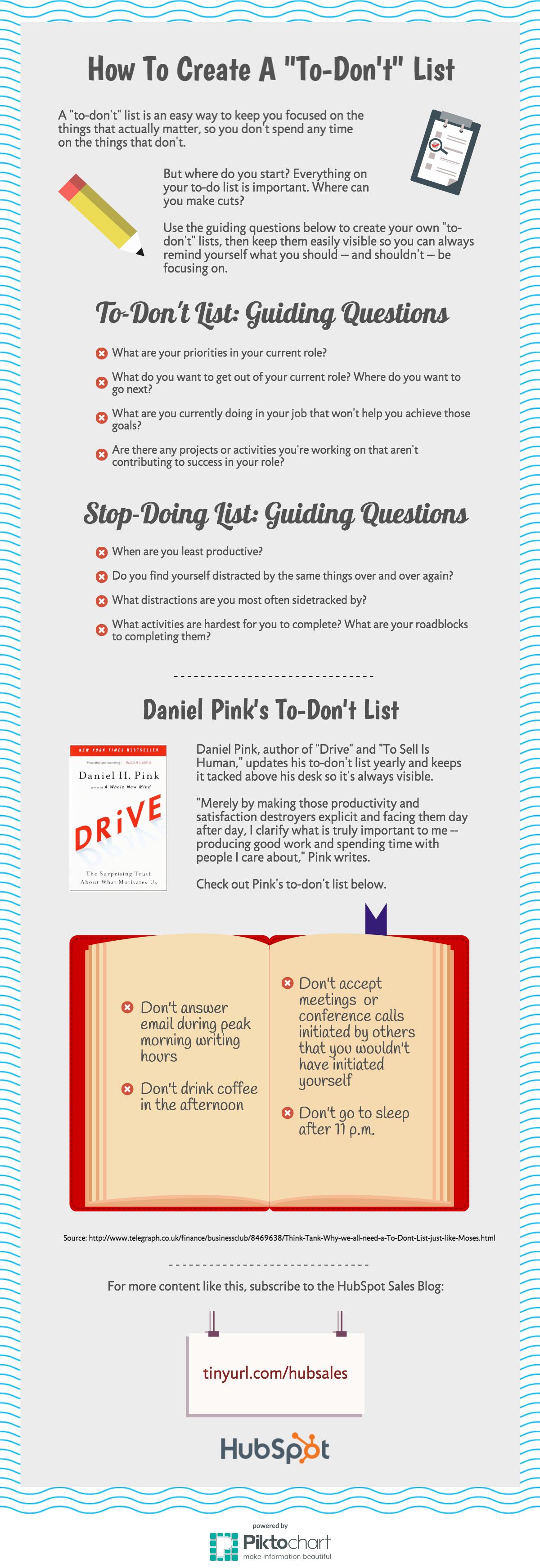

Share this Image On Your Site
Please include attribution to blog.hubspot.com/sales with this graphic.
Friday, November 27, 2015
Why Last Year’s Holiday Ecommerce Sales Numbers Are Changing 2015 Expectations

You don’t need anyone to tell you that the holidays are a major opportunity for retailers everywhere (online or offline). But you might be surprised by the level of importance they carry and how some of these trends are changing.
RJMetrics analyzed data from hundreds of ecommerce stores. Some of what we found wasn’t too surprising – Black Friday and Cyber Monday are major shopping days for any ecommerce retailer. But some findings were a little more unexpected. The big one? For the past five years online retailers have been generating a decreasing percentage of their annual revenue during holiday months.
Read on for what’s behind these trends, and how they are changing expectations for the upcoming weeks.
How Important Was Last Holiday Season to Ecommerce Companies?
Overall, the months of November and December account for more than 20% of total annual revenue.
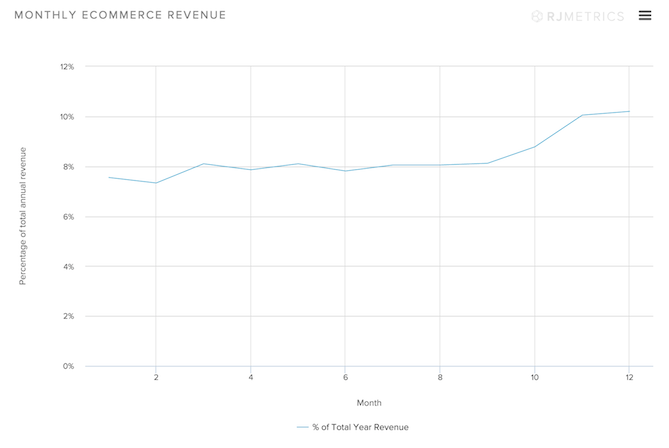
On average, these “holiday shopping months” bring in 30% more revenue than non-holiday months.
Is This Normal?
Without a doubt, the holiday season is an important time for ecommerce companies. But you can add some additional context when you segment this data by year.
Since 2010, the holiday months of November and December are comprising a shrinking portion of total annual revenue. While ecommerce sales as a whole are growing – up 15.4% since 2013 according to the U.S. commerce department – retailers are generating a bigger chunk of this revenue during non-holiday months.
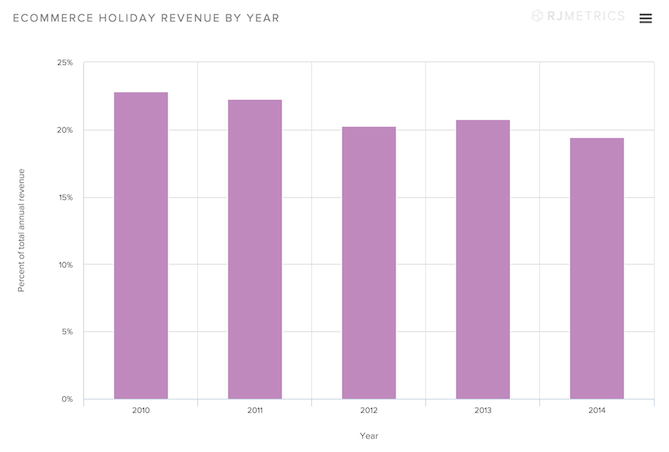
This chart does not in any way indicate that the health of ecommerce is decreasing, only that the holiday season is becoming less important to overall sales numbers.
Are All Categories of Ecommerce Decreasing Their Reliance on the Holiday Season?
As you can probably predict, this breakdown differs across ecommerce categories.
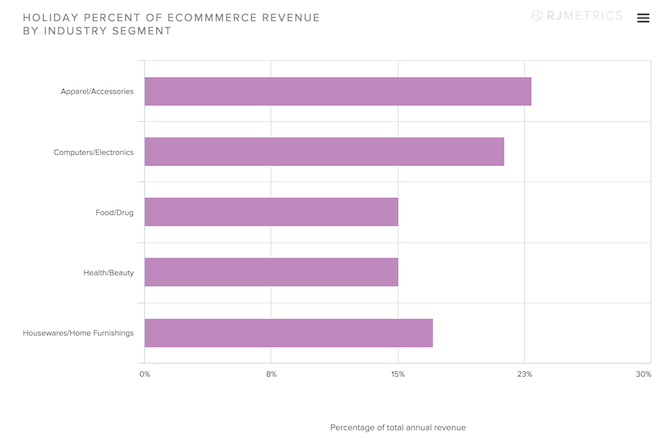
When we looked at the importance of the holiday season by category, predictably Apparel/Accessories and Computer/Electronics companies are much more “holiday-sensitive”. This means that a greater percentage of their total annual revenue is generated during holiday months than Food/Drug, Health/Beauty, and Housewares/Home Furnishings categories.
The decreasing importance of the holiday season over the years is even more pronounced for holiday-sensitive categories.
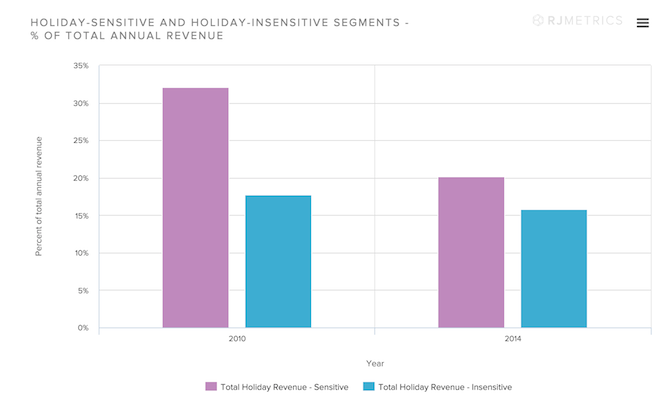
The two holiday-sensitive segments, Apparel/Accessories and Computer/Electronics, are being disproportionately impacted by this trend. In 2010, holiday-sensitive categories were generating 32% of their total annual revenue during the holiday months. In 2014, they generated 20% of their total annual revenue during the holiday months, a massive 12 percentage point drop over the past 4 years.
Interestingly, since 2012, holiday shopping has made up only 16% of annual revenue for “holiday-insensitive” companies, which means that these categories actually generate less revenue during the holiday months than they do during the rest of the year.
Why the Leveling Out?
With data it’s often easier to answer “What happened?” than it is to answer “Why?”
"Traditional retailers, both catalog and brick-and-mortar, rely heavily on holiday shopping to hit their annual revenue targets. But today’s most innovative online retailers—companies like Mizzen & Main, Harry’s, Plated, and more—build relationships with their customers throughout the year. They use subscription models to create regular purchase habits, build high-quality brands to nurture affinity, and use effective (but not always discount-based) retention marketing. Because of this, they’re less reliant on holiday shopping than traditional retailers."
While the Holiday Season is Losing Some Importance, Black Friday and Cyber Monday Continue Surging
When we looked at revenue on a daily timeline, we saw that Black Friday and Cyber Monday were huge contributors to the revenue generated during the holiday season.
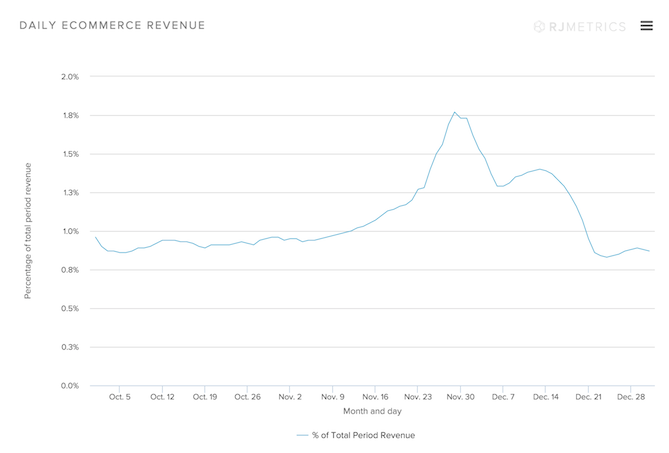
The holiday season is decreasing in importance for most companies, but the days from Black Friday through Christmas still pack a punch, generating 50-100% more revenue than the other non-holiday shopping days throughout the rest of the year.
This uptick is even more pronounced for the “holiday-sensitive” categories we mentioned earlier.
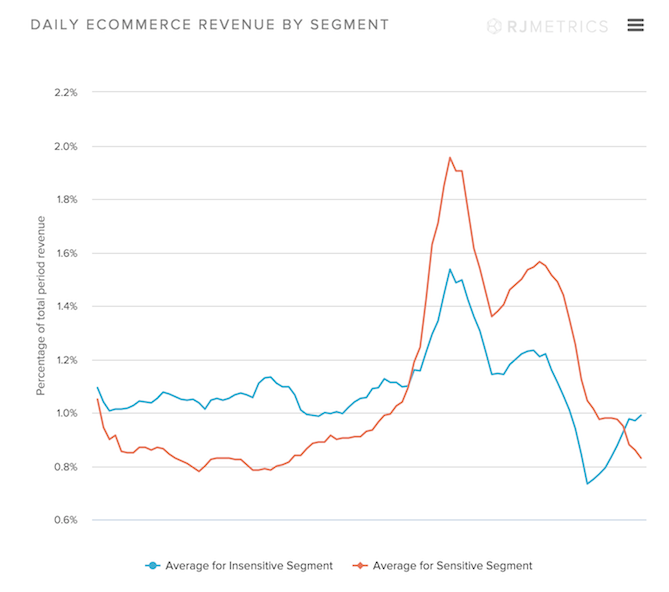
Specifically, Cyber Monday is important for any ecommerce retailer. While online sales in general rose 23% YOY from Thanksgiving day to Cyber Monday, last year’s Cyber Monday generated $2.3 billion, 29% higher than 2013’s figures.
IBM also reported that Cyber Monday sales were greater than both Thanksgiving and Black Friday.
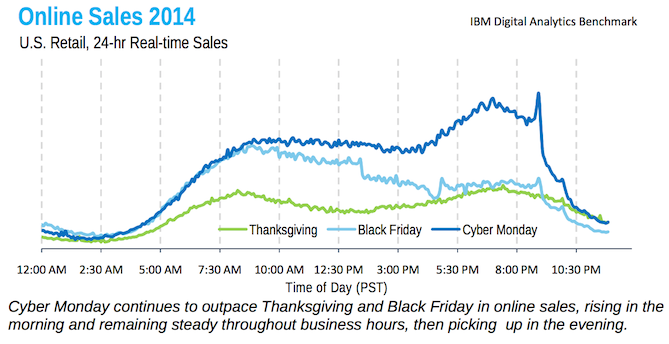
What Does This Mean for Your Ecommerce Business?
There are two important takeaways from this data that every online retailer should be paying attention to:
1) Focus Your Efforts on the Key Shopping Days
While November and December aren’t carrying the same weight as they used to, it’s clear November 27th to the 30th will still be crucial to any retailer looking to close out the year with strong numbers.
There are a number of strategies to help you maximize your sales efficiency during this period, from optimizing your mobile buying experience to personalizing your interactions with shoppers, building customer loyalty from customers looking to change brands to changing your Google Adwords bidding strategy during the holiday season.
2) Invest in Your Year-Round Strategy
Ecommerce retailers are less reliant on November and December sales, and that’s a good thing! Holiday shoppers are notoriously demanding of discounts and 71% expect free shipping (47% expect free returns). Rather than relying on the holiday season to be their primary growth driver, forward-thinking businesses are finding ways to drive growth throughout the year.
To dig deeper into these trends, check out the full Ecommerce Holiday Trends report from RJMetrics here.
The Right Way to Reduce Your Churn Rate

Some customers are past saving. They’ve made their decision to leave, and they'll be out just as soon as they can find the “cancel” button.
Of course you don't want them to leave -- nor do you want more customers following suit.
To prevent more customers from leaving, you need to ask yourself tough questions: How did your churned customer get to that point? And once they’re at that point, is there anything you can do to save the account?
Let’s Not Play “Hide the Cancel Button”
Recently, I was on the other end of the churn process -- and it got me thinking about those tough questions. I decided to cancel my subscription service to a local CSA. It delivered fresh fruits and vegetables to my door twice a month from local farms, but neither the prices nor the quality of the produce impressed me compared to the local supermarket.
I went onto my online account and spent 20 minutes trying to find a way to cancel ... and came up with nothing.
Finally, I just emailed them. “Hi, how do I cancel?”
The CSA's response:
Thank you for your recent inquiry. You may close your account at any time by calling or emailing us with a clearly stated request to cancel your account and a reason for cancellation. We will process this request as soon as possible.
When your account is canceled, we invite you to return at any time. You can always resume your services by logging on to your account online and clicking the link to reactivate, or by giving us a call and asking to have your account reactivated.”
Besides the fact that I was clearly speaking with a robot, the CSA's customer retention strategy was transparent: Force customers to have a difficult conversation before they go as a deterrent to leaving.
As retaining technique, hiding the cancel button doesn’t work at all. You're just delaying the inevitable. As any number of ex-boyfriends and ex-girlfriends can tell you, when you’re out, you’re out. Having to go through a hard talk to get there isn’t going to keep anyone around.
The CSA could have handled this much better and perhaps even have kept my account. Here's what the cancel process should have looked like.
How to Set Up a Cancellation Process the Right Way
When a customer is jumping ship, you have a few opportunities that can turn one loss into long-term gain.
1) Have an easily accessible “Cancel” button.
2) This cancel button should auto-trigger an exit survey to find out:
a) What the customer expected to get.
b) What the customer thinks they’ve actually received (or not).
c) If there’s anything that might get them to stay.
3) Look for patterns in the responses.
People leave a service when there is a mismatch between what they hoped to achieve and what they were actually able to do.
Once you have this information, you can look for patterns that can tell you how well your company tells its story and targets the right customers. Then, you can use that information to build better policies and procedures for customer success.
(Hint: If they say “lower the price,” that doesn’t mean you should lower the price -- but rather that you have failed to impart the value of your service).
4) After the survey, include another page with succinct (yet friendly) copy that reminds them of why they signed up in the first place -- and what they’ll lose by cancelling.
This is where the CSA also took a misstep. I was welcome back any time with no penalty (not that there should be penalties -- that’s no way to make friends!).
But if there had been a loyalty rewards program -- maybe when you buy 10 boxes, you get the 11th one free -- it could have had returning customers forfeit their pre-cancellation points. For another SaaS business, what departing customers lose could be saved data or the investment in the product up to this point. Weight the decision to cancel with consequences that exiting customers have to consider carefully -- but also give them the cancellation button. Don’t hide it.
Besides highlighting what I was giving up, the CSA could have:
- Reminded me why I joined -- which was to support local farms and receive fresher (closer) produce.
- Created an email campaign introducing me to local farmers, telling me which seasonal fruits and vegetables were ripening, and upselling me to fresh-made jams.
- Helped me feel like part of a close community of farm-to-table supporters in my local area by hosing a lively Facebook group or even a Meetup group.
In other words, it needed to remind me that price wasn’t the point of the CSA -- being an integral part of the local food community was.
Once a customer’s decision is made, it’s frankly very hard to change. They’ve already sold themselves on the idea that your service isn’t worth the money.
But remember -- your customers don’t want to leave. They want to love you! So instead of trying to make cancellation harder, use entrance and exit surveys to get smarter about acquiring new customers and keeping the ones you already have happy.
How to Generate More Leads With Content Marketing [Free Online Course]

According to research, 93% of B2B marketers use content marketing, but only 42% are actually effective at it.
Why such a big gap? As with most things, it comes down to a lack of education on what actually works and how to plan and execute on your campaign in the most effective way.
HubSpot recently teamed up with online learning platform Dot Native to create a master class in lead generation. This course is designed to cover the techniques required to plan, create, promote, and measure your content marketing campaigns to ensure their success.
The difference between a good content campaign and a great one can be hundreds of leads. So to make sure yours is the best it can be, this free course will touch on 50 actionable lead generation tips, including:
- How to ensure your campaign is aligned with your business strategy
- How to hit all your deadlines
- How and where to promote your content
- What free tools to use to amplify your reach
- How to optimise your email marketing campaigns
- Advice on measuring success
By signing up for this master class you'll also receive unlimited access to all Dot Native courses and master classes completely free for seven days. Click here to sign up for the class today.
 Click to Tweet:
Click to Tweet:
"Learn how to generate leads from your content marketing in just 40 minutes with this awesome master class"
Why Everyone Should Be Moving To HTTP/2
Please visit Search Engine Land for the full article.
Thursday, November 26, 2015
Why Gratitude Is the Secret to Good Health & Happiness [Infographic]

"Gratitude means thankfulness, counting your blessings, noticing simple pleasures, and acknowledging everything you receive," wrote Marelisa Fabrega in her book How Gratitude Can Change Your Life.
Practicing gratitude doesn't just make you a more likeable person, but it can also benefit your health. In a study of character strengths, gratitude was found to be the best predictor of wellbeing. Another study found that men and women with heart disease who practiced gratitude showed significant improvement in heart health.
Not to mention, it can also make you happier. Research shows gratitude trumps optimism, spirituality, and emotional self-awareness when it comes to bringing greater positivity and satisfaction into our lives.
Need more reasons to practice gratitude during the season of giving thanks? Check out the infographic below from Happify to learn how else gratitude can increase health and happiness.





